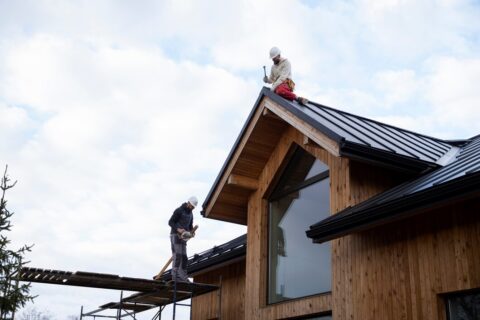How to Protect Your Roof from Ottawa’s Harsh Winters
Ottawa’s winters can be particularly tough on your roof, with heavy snowfall, ice accumulation, and freezing temperatures. Keeping your roof in good shape during this season is crucial for protecting your home. A well-maintained roof not only keeps the cold out but also ensures that your house remains structurally sound throughout the winter months.
Preparing your roof for winter involves a combination of preemptive measures and ongoing maintenance. By taking the right steps before the first snowfall, you can avoid common problems like leaks, ice dams, and damage caused by heavy snow loads. Regular inspections and maintenance tasks are essential for identifying and addressing potential issues early on.
In this article, I’ll share some effective strategies to help you protect your roof from the harsh winter weather in Ottawa. From essential winter roofing tips to long-term solutions, these insights will help you ensure your roof remains in top condition, providing reliable protection for your home all season long.
Preparing Your Roof Before Winter Hits
Importance of Pre-Winter Inspections
Pre-winter inspections are essential to catch any issues before the harsh weather sets in. A thorough inspection can identify weak spots, leaks, and damage that may worsen under the weight of snow and ice. By addressing these problems early, you can prevent more extensive damage and costly repairs down the road. An inspection will also check for loose or missing shingles, cracked flashing, and other vulnerabilities that could compromise your roof’s ability to shed water and snow effectively.
Scheduling a professional roof inspection ensures that all potential problems are spotted and addressed. Professionals have the experience and tools to detect subtle signs of wear that homeowners might miss. By taking this proactive step, you’re not only safeguarding your roof but also ensuring the safety and comfort of your home during the winter months.
Necessary Repairs and Maintenance
Once the inspection is complete, it’s crucial to perform any necessary repairs and maintenance. This may include replacing damaged shingles, fixing leaks, and sealing gaps around chimneys and vents. Making these repairs before winter hits ensures that your roof is in optimal condition to withstand the upcoming cold and snow. Additionally, reinforcing weak areas can prevent structural damage caused by heavy snow loads and ice accumulation.
Beyond repairs, routine maintenance tasks like cleaning gutters and downspouts are vital. Clogged gutters can cause water to back up and freeze, leading to ice dams that can damage your roof and home’s interior. Also, ensure that attic insulation and ventilation are adequate, as poor ventilation can lead to moisture build-up and ice dam formation. By addressing these maintenance needs, you enhance your roof’s resilience to winter weather.
Essential Winter Roofing Tips
Keeping Gutters Clean and Free of Debris
One of the most vital winter roofing tips is to keep your gutters clean and free of debris. Leaves, twigs, and other debris can clog gutters, preventing proper drainage and leading to ice dams. Ice dams form when water backs up behind the blockage and freezes, causing a dam of ice that can force water under your roof and into your home. Regularly cleaning your gutters ensures that water flows freely away from your roof, reducing the risk of ice dams and related damage.
It’s a good idea to clean your gutters in late fall, after the leaves have finished falling. You might also consider installing gutter guards to prevent debris from accumulating in the first place. Ensuring your downspouts are clear and directing water away from your home’s foundation helps protect your roof and the structure of your house.
Ensuring Proper Attic Ventilation
Proper attic ventilation plays a crucial role in maintaining your roof during the winter. Good ventilation helps to regulate the temperature in your attic, reducing the risk of ice dams. When warm air from your home rises into the attic, it can melt the snow on your roof. This melted snow can then refreeze at the roof’s edge, forming ice dams. By ensuring your attic has adequate ventilation, you allow cold air to circulate, keeping the roof cooler and preventing the snow from melting and refreezing.
In addition to preventing ice dams, proper ventilation helps to prevent moisture build-up in your attic. Moisture can lead to mould growth and wood rot, both of which can compromise the structural integrity of your roof. Check your attic for proper insulation and ventilation before winter sets in to ensure your roof and home are protected from the elements. If you’re unsure about your attic’s ventilation, consulting a professional roofer can provide the guidance you need.
Dealing with Snow and Ice
Safe Snow Removal Techniques
Removing snow from your roof is essential for preventing damage, but it must be done safely. Using a roof rake is one of the safest methods for snow removal. This tool allows you to clear snow from the edge of your roof while standing on the ground, reducing the risk of falls. It’s important to use a roof rake with a long handle and a plastic blade to avoid damaging the shingles.
If you must climb onto the roof, take extreme caution. Ensure you wear slip-resistant footwear and use a secure ladder. Avoid using metal tools, as they can damage the roof surface. Instead, opt for plastic shovels or snow rakes. Never use salt or ice melt directly on your roof, as these chemicals can degrade the roofing materials and harm surrounding vegetation. Always work in small sections to avoid overloading the roof with your weight and the snow you’re removing.
Preventing Ice Dams and Related Damage
Ice dams are a common winter roofing problem caused by the melting and refreezing of snow on your roof. They can lead to water infiltration, shingle damage, and even interior leaks. To prevent ice dams, ensure your attic is well-insulated and ventilated. Proper insulation keeps warm air from escaping into the attic, while ventilation helps maintain a consistent roof temperature.
Another effective strategy is installing heated cables along your roof’s edge. These cables help melt ice and snow, allowing water to flow freely to the gutters and away from your home. Regularly clearing snow and ice from the roof and gutters also helps prevent ice dams from forming. By taking these proactive measures, you can protect your roof from the harmful effects of ice dams and ensure your home stays dry and safe all winter long.
Long-Term Strategies for Winter Roof Protection
Investing in Durable Roofing Materials
Choosing durable roofing materials is a key long-term strategy for winter roof protection. Materials like metal roofing, asphalt shingles, and slate are known for their durability and ability to withstand harsh weather conditions. Metal roofs, for example, are highly resistant to snow and ice build-up and can easily shed snow, reducing the risk of ice dams.
When selecting roofing materials, consider those with a high wind resistance rating and a low absorption rate. These features ensure that the materials can withstand heavy snowfall and icy conditions without sustaining damage. Additionally, invest in high-quality underlayment to provide an extra layer of protection against moisture. By investing in these durable materials, you enhance your roof’s resilience and longevity, ensuring it protects your home for years to come.
Implementing Annual Roof Maintenance Plans
An annual roof maintenance plan is essential for keeping your roof in top condition year-round. Regular inspections and timely repairs help to identify and address issues before they become major problems, particularly as winter approaches. Scheduling a professional roof inspection each fall ensures that your roof is ready to face the winter weather.
Beyond inspections, annual maintenance should include gutter cleaning, attic ventilation checks, and shingle repair or replacement. Keeping up with these tasks reduces the risk of winter damage and extends the overall lifespan of your roof. Consistent maintenance also helps to preserve your roof’s appearance and functionality, providing peace of mind that your home is well-protected.
Final Thoughts
Taking steps to protect your roof from Ottawa’s harsh winters is crucial for maintaining the safety and comfort of your home. From conducting pre-winter inspections and performing necessary repairs to following essential winter roofing tips and implementing long-term strategies, these actions ensure your roof remains in top shape. Harsh winter weather can pose significant challenges, but with proper maintenance and preparation, you can prevent damage and extend your roof’s lifespan.
Remember, investing in durable materials and regular maintenance saves you time, money, and stress in the long run. If you’re unsure about the best practices for winter roof protection or need professional assistance, it’s always wise to consult with trusted roofing experts.
For expert advice and professional roofing services, contact Magnum Roofing. Our team is dedicated to helping you maintain a strong and reliable roof through every season. Don’t wait until problems arise—schedule your roof maintenance with Magnum Roofing today and ensure your home is ready for whatever winter throws its way.


